Financial Statement Analysis Report: Flight Centre Travel Group
VerifiedAdded on 2020/02/24
|10
|2229
|72
Report
AI Summary
This report provides a comprehensive financial statement analysis of Flight Centre Travel Group Ltd. It begins with an introduction to the company, its industry context, and strategic plans. The analysis focuses on the statement of financial performance, statement of financial position, and statement of cash flows, utilizing common-size and trend analysis. Ratio analysis, including liquidity, profitability, solvency, and cash flow adequacy, is also conducted to assess the company's financial health. The report highlights the company's performance trends, including inconsistencies in gross profit and net income, and assesses the company's liquidity, solvency, profitability and cash flow adequacy. The conclusion offers recommendations for management to improve financial performance, such as reducing current liabilities, controlling expenses, and optimizing debt usage. Appendices include tables supporting the financial analysis, such as common-size statements and ratio calculations. Overall, the report offers a detailed evaluation of Flight Centre's financial position and performance.
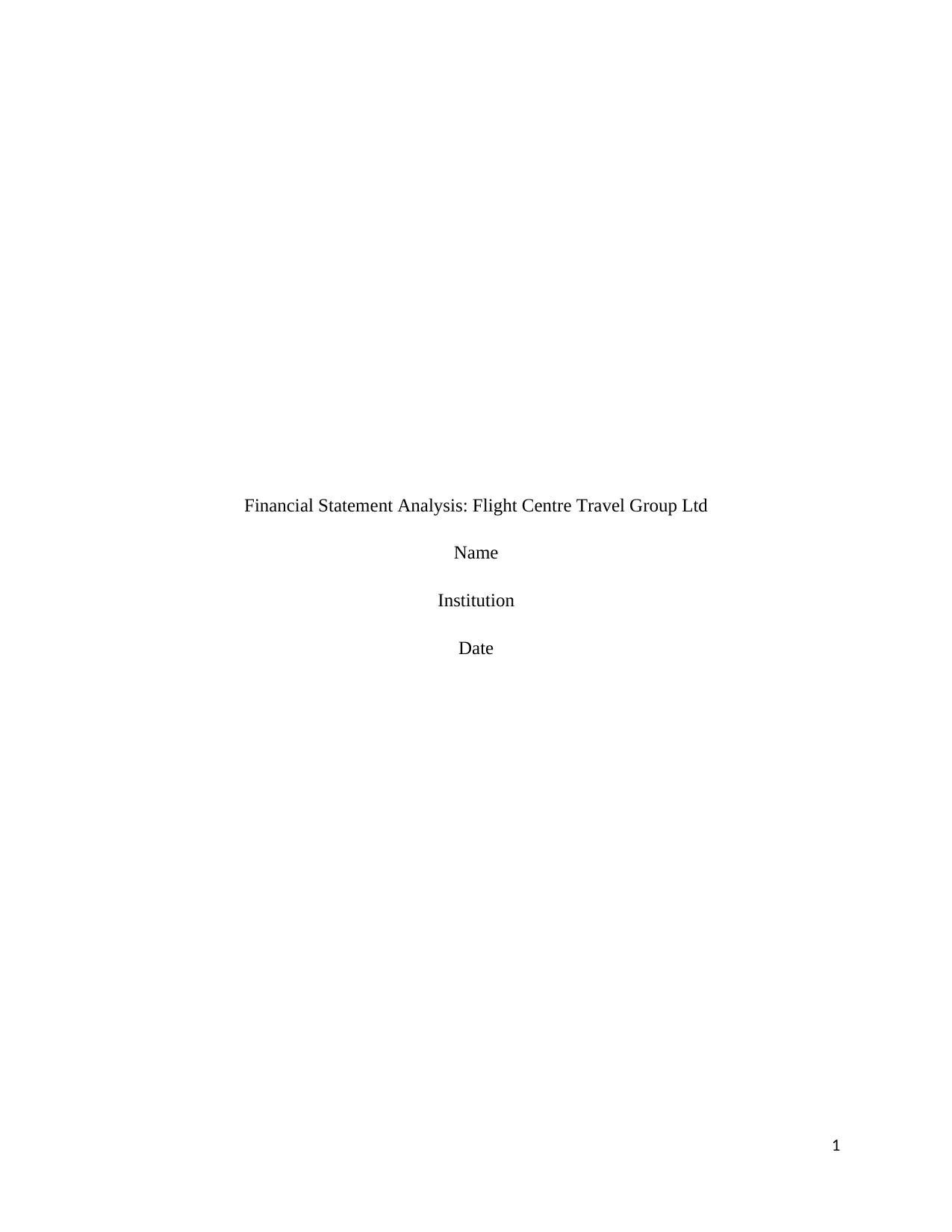
Financial Statement Analysis: Flight Centre Travel Group Ltd
Name
Institution
Date
1
Name
Institution
Date
1
Paraphrase This Document
Need a fresh take? Get an instant paraphrase of this document with our AI Paraphraser
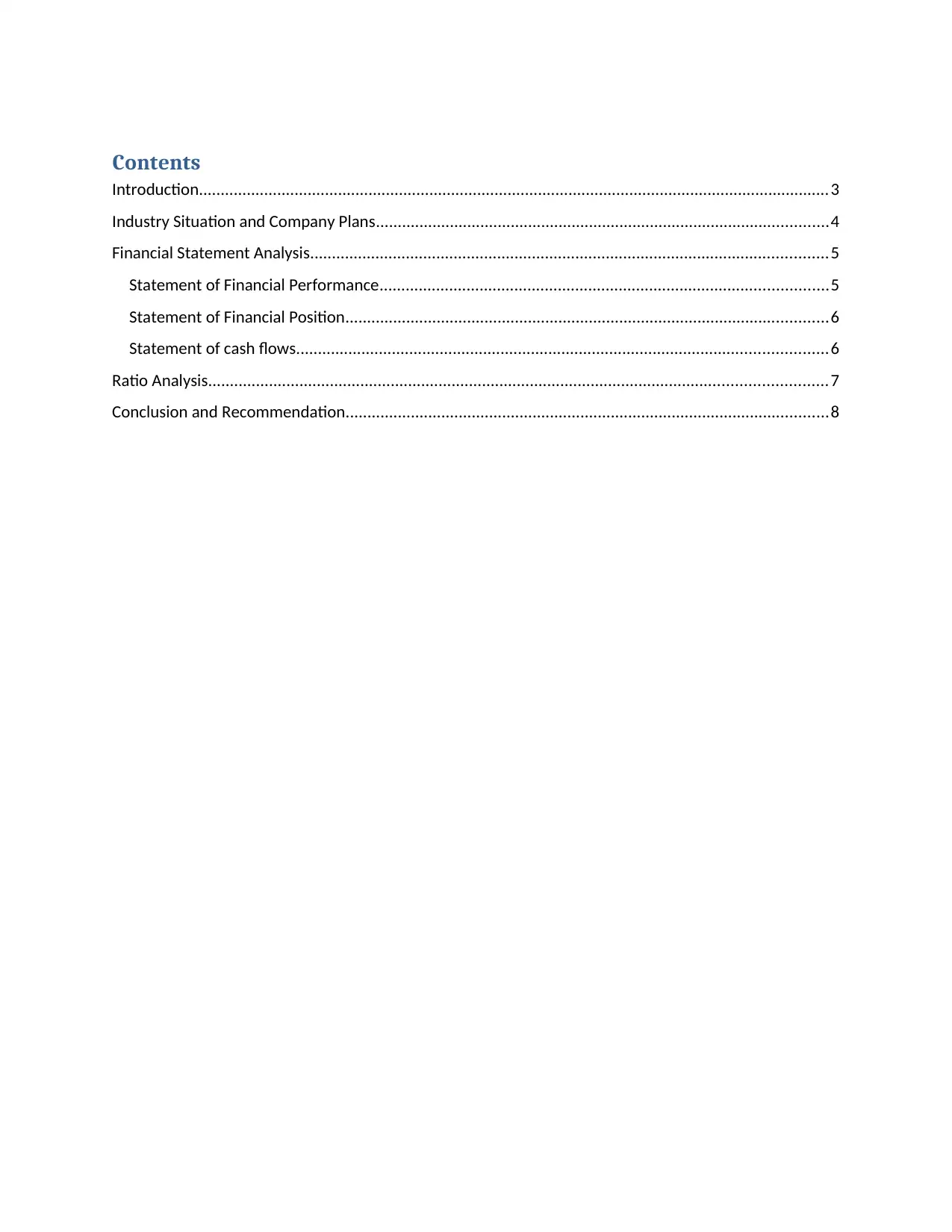
Contents
Introduction.................................................................................................................................................3
Industry Situation and Company Plans........................................................................................................4
Financial Statement Analysis.......................................................................................................................5
Statement of Financial Performance.......................................................................................................5
Statement of Financial Position...............................................................................................................6
Statement of cash flows..........................................................................................................................6
Ratio Analysis..............................................................................................................................................7
Conclusion and Recommendation...............................................................................................................8
Introduction.................................................................................................................................................3
Industry Situation and Company Plans........................................................................................................4
Financial Statement Analysis.......................................................................................................................5
Statement of Financial Performance.......................................................................................................5
Statement of Financial Position...............................................................................................................6
Statement of cash flows..........................................................................................................................6
Ratio Analysis..............................................................................................................................................7
Conclusion and Recommendation...............................................................................................................8
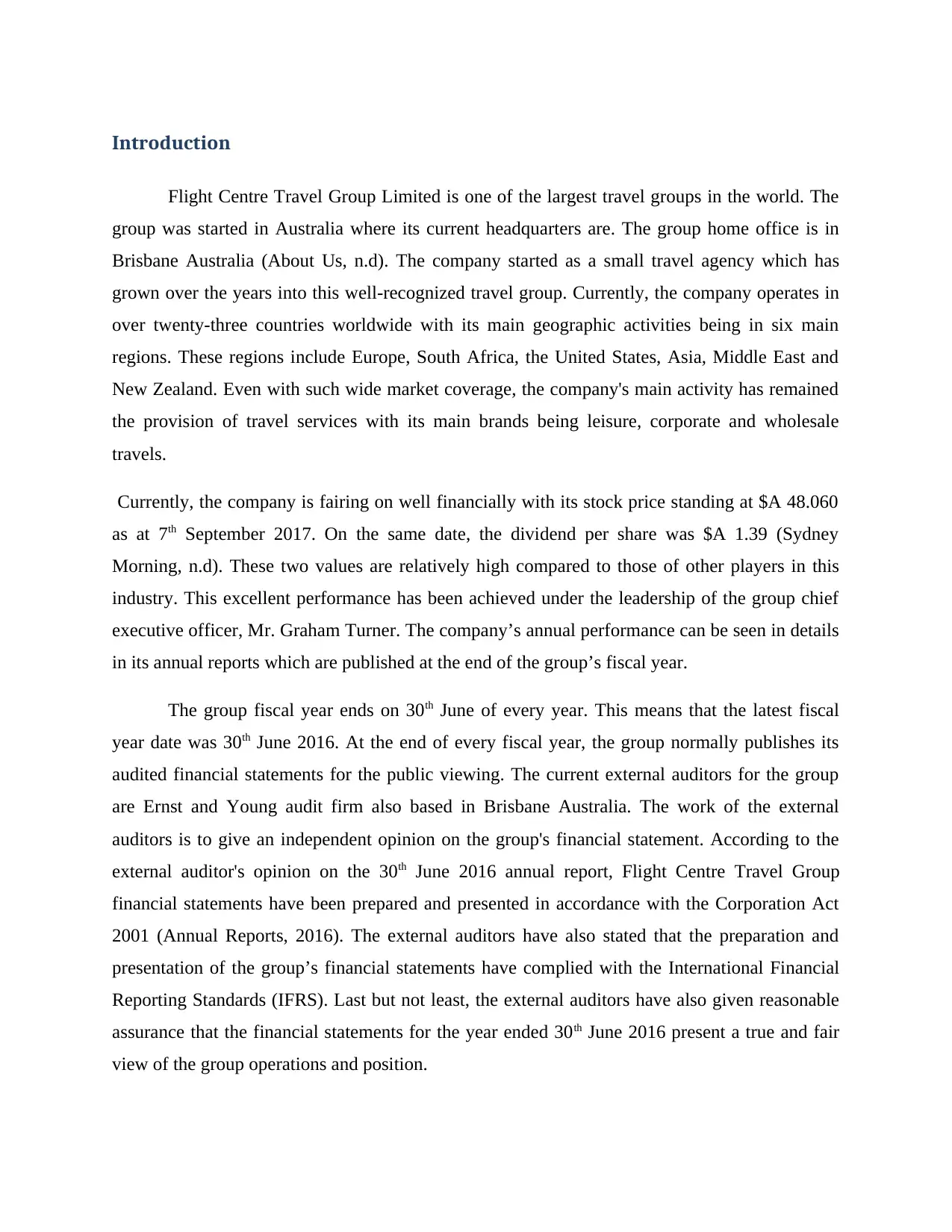
Introduction
Flight Centre Travel Group Limited is one of the largest travel groups in the world. The
group was started in Australia where its current headquarters are. The group home office is in
Brisbane Australia (About Us, n.d). The company started as a small travel agency which has
grown over the years into this well-recognized travel group. Currently, the company operates in
over twenty-three countries worldwide with its main geographic activities being in six main
regions. These regions include Europe, South Africa, the United States, Asia, Middle East and
New Zealand. Even with such wide market coverage, the company's main activity has remained
the provision of travel services with its main brands being leisure, corporate and wholesale
travels.
Currently, the company is fairing on well financially with its stock price standing at $A 48.060
as at 7th September 2017. On the same date, the dividend per share was $A 1.39 (Sydney
Morning, n.d). These two values are relatively high compared to those of other players in this
industry. This excellent performance has been achieved under the leadership of the group chief
executive officer, Mr. Graham Turner. The company’s annual performance can be seen in details
in its annual reports which are published at the end of the group’s fiscal year.
The group fiscal year ends on 30th June of every year. This means that the latest fiscal
year date was 30th June 2016. At the end of every fiscal year, the group normally publishes its
audited financial statements for the public viewing. The current external auditors for the group
are Ernst and Young audit firm also based in Brisbane Australia. The work of the external
auditors is to give an independent opinion on the group's financial statement. According to the
external auditor's opinion on the 30th June 2016 annual report, Flight Centre Travel Group
financial statements have been prepared and presented in accordance with the Corporation Act
2001 (Annual Reports, 2016). The external auditors have also stated that the preparation and
presentation of the group’s financial statements have complied with the International Financial
Reporting Standards (IFRS). Last but not least, the external auditors have also given reasonable
assurance that the financial statements for the year ended 30th June 2016 present a true and fair
view of the group operations and position.
Flight Centre Travel Group Limited is one of the largest travel groups in the world. The
group was started in Australia where its current headquarters are. The group home office is in
Brisbane Australia (About Us, n.d). The company started as a small travel agency which has
grown over the years into this well-recognized travel group. Currently, the company operates in
over twenty-three countries worldwide with its main geographic activities being in six main
regions. These regions include Europe, South Africa, the United States, Asia, Middle East and
New Zealand. Even with such wide market coverage, the company's main activity has remained
the provision of travel services with its main brands being leisure, corporate and wholesale
travels.
Currently, the company is fairing on well financially with its stock price standing at $A 48.060
as at 7th September 2017. On the same date, the dividend per share was $A 1.39 (Sydney
Morning, n.d). These two values are relatively high compared to those of other players in this
industry. This excellent performance has been achieved under the leadership of the group chief
executive officer, Mr. Graham Turner. The company’s annual performance can be seen in details
in its annual reports which are published at the end of the group’s fiscal year.
The group fiscal year ends on 30th June of every year. This means that the latest fiscal
year date was 30th June 2016. At the end of every fiscal year, the group normally publishes its
audited financial statements for the public viewing. The current external auditors for the group
are Ernst and Young audit firm also based in Brisbane Australia. The work of the external
auditors is to give an independent opinion on the group's financial statement. According to the
external auditor's opinion on the 30th June 2016 annual report, Flight Centre Travel Group
financial statements have been prepared and presented in accordance with the Corporation Act
2001 (Annual Reports, 2016). The external auditors have also stated that the preparation and
presentation of the group’s financial statements have complied with the International Financial
Reporting Standards (IFRS). Last but not least, the external auditors have also given reasonable
assurance that the financial statements for the year ended 30th June 2016 present a true and fair
view of the group operations and position.
⊘ This is a preview!⊘
Do you want full access?
Subscribe today to unlock all pages.

Trusted by 1+ million students worldwide
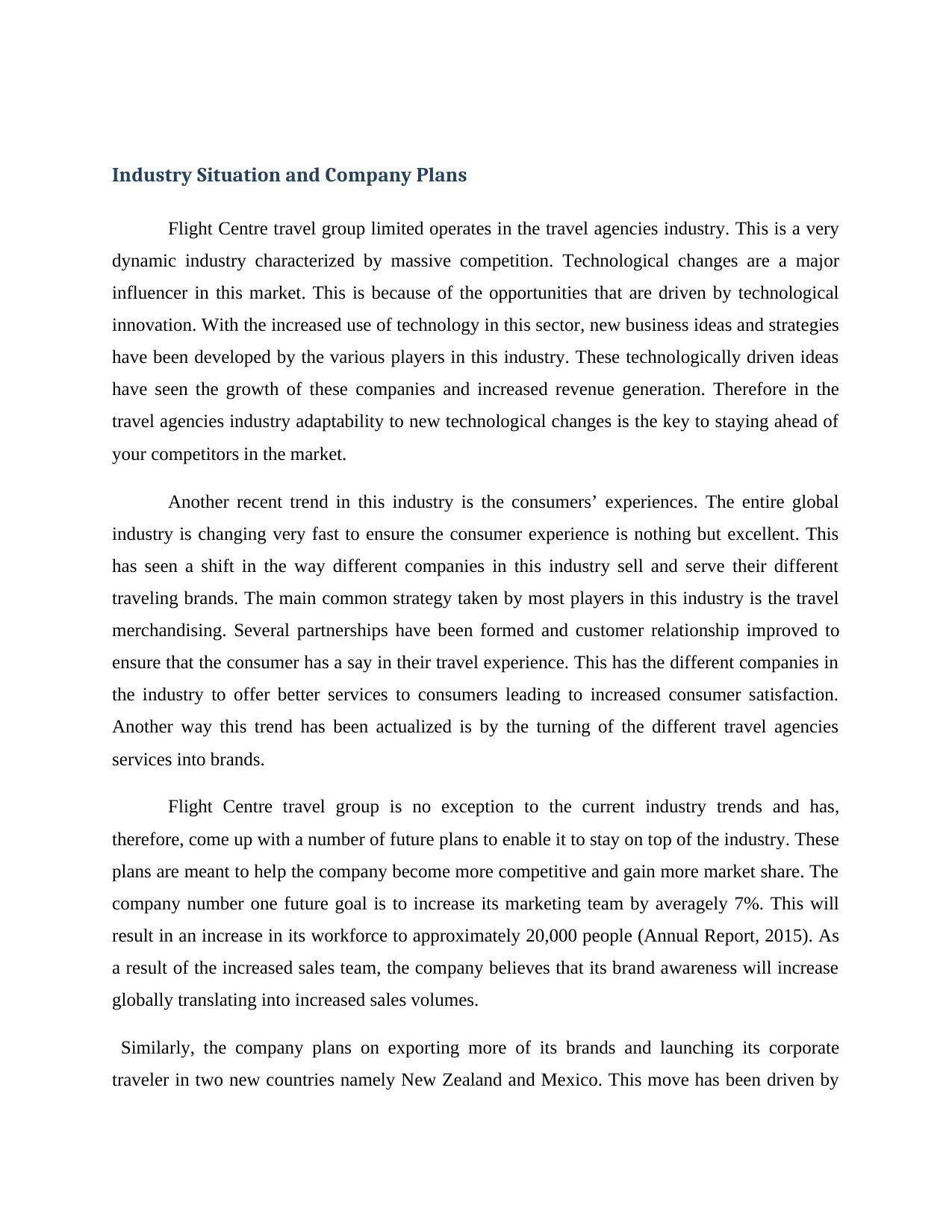
Industry Situation and Company Plans
Flight Centre travel group limited operates in the travel agencies industry. This is a very
dynamic industry characterized by massive competition. Technological changes are a major
influencer in this market. This is because of the opportunities that are driven by technological
innovation. With the increased use of technology in this sector, new business ideas and strategies
have been developed by the various players in this industry. These technologically driven ideas
have seen the growth of these companies and increased revenue generation. Therefore in the
travel agencies industry adaptability to new technological changes is the key to staying ahead of
your competitors in the market.
Another recent trend in this industry is the consumers’ experiences. The entire global
industry is changing very fast to ensure the consumer experience is nothing but excellent. This
has seen a shift in the way different companies in this industry sell and serve their different
traveling brands. The main common strategy taken by most players in this industry is the travel
merchandising. Several partnerships have been formed and customer relationship improved to
ensure that the consumer has a say in their travel experience. This has the different companies in
the industry to offer better services to consumers leading to increased consumer satisfaction.
Another way this trend has been actualized is by the turning of the different travel agencies
services into brands.
Flight Centre travel group is no exception to the current industry trends and has,
therefore, come up with a number of future plans to enable it to stay on top of the industry. These
plans are meant to help the company become more competitive and gain more market share. The
company number one future goal is to increase its marketing team by averagely 7%. This will
result in an increase in its workforce to approximately 20,000 people (Annual Report, 2015). As
a result of the increased sales team, the company believes that its brand awareness will increase
globally translating into increased sales volumes.
Similarly, the company plans on exporting more of its brands and launching its corporate
traveler in two new countries namely New Zealand and Mexico. This move has been driven by
Flight Centre travel group limited operates in the travel agencies industry. This is a very
dynamic industry characterized by massive competition. Technological changes are a major
influencer in this market. This is because of the opportunities that are driven by technological
innovation. With the increased use of technology in this sector, new business ideas and strategies
have been developed by the various players in this industry. These technologically driven ideas
have seen the growth of these companies and increased revenue generation. Therefore in the
travel agencies industry adaptability to new technological changes is the key to staying ahead of
your competitors in the market.
Another recent trend in this industry is the consumers’ experiences. The entire global
industry is changing very fast to ensure the consumer experience is nothing but excellent. This
has seen a shift in the way different companies in this industry sell and serve their different
traveling brands. The main common strategy taken by most players in this industry is the travel
merchandising. Several partnerships have been formed and customer relationship improved to
ensure that the consumer has a say in their travel experience. This has the different companies in
the industry to offer better services to consumers leading to increased consumer satisfaction.
Another way this trend has been actualized is by the turning of the different travel agencies
services into brands.
Flight Centre travel group is no exception to the current industry trends and has,
therefore, come up with a number of future plans to enable it to stay on top of the industry. These
plans are meant to help the company become more competitive and gain more market share. The
company number one future goal is to increase its marketing team by averagely 7%. This will
result in an increase in its workforce to approximately 20,000 people (Annual Report, 2015). As
a result of the increased sales team, the company believes that its brand awareness will increase
globally translating into increased sales volumes.
Similarly, the company plans on exporting more of its brands and launching its corporate
traveler in two new countries namely New Zealand and Mexico. This move has been driven by
Paraphrase This Document
Need a fresh take? Get an instant paraphrase of this document with our AI Paraphraser
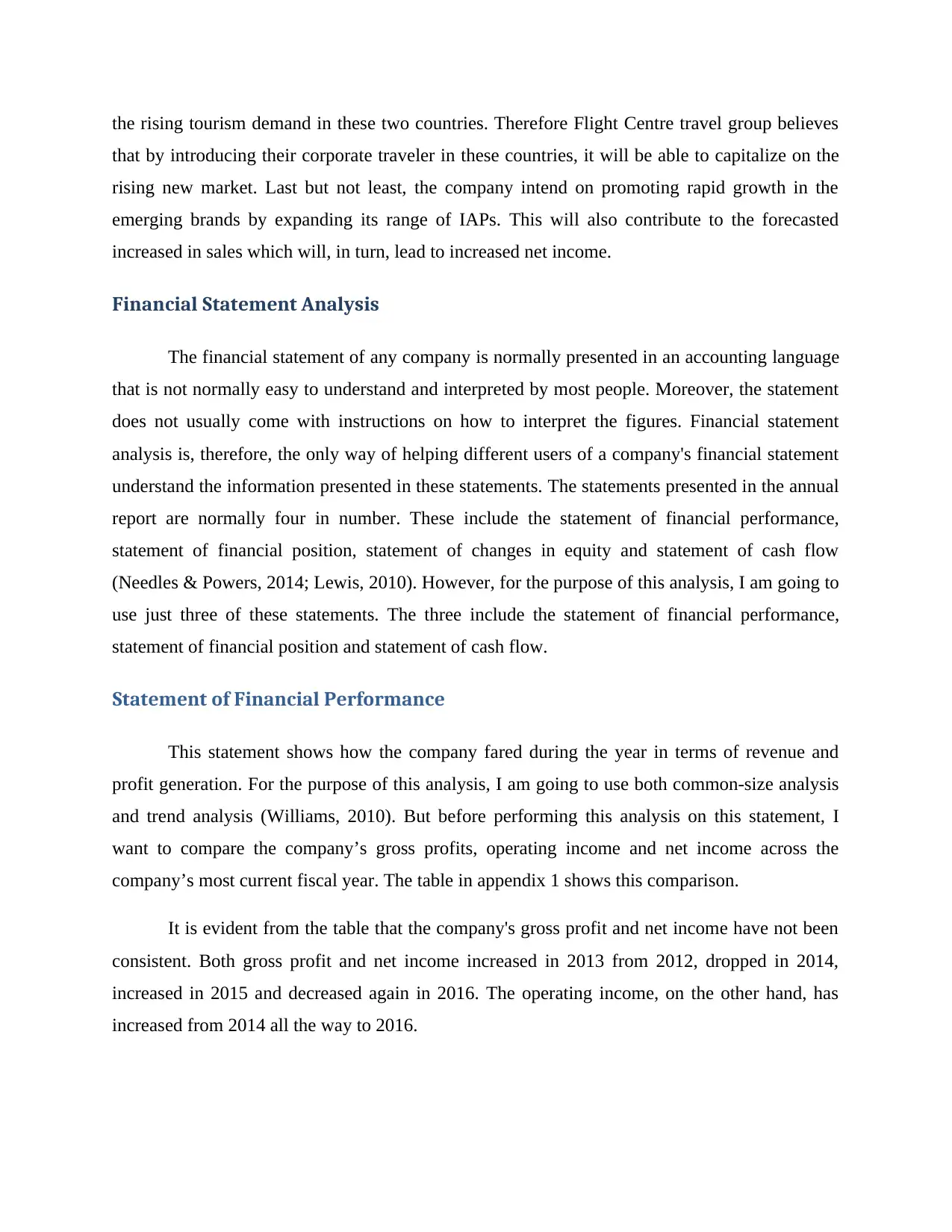
the rising tourism demand in these two countries. Therefore Flight Centre travel group believes
that by introducing their corporate traveler in these countries, it will be able to capitalize on the
rising new market. Last but not least, the company intend on promoting rapid growth in the
emerging brands by expanding its range of IAPs. This will also contribute to the forecasted
increased in sales which will, in turn, lead to increased net income.
Financial Statement Analysis
The financial statement of any company is normally presented in an accounting language
that is not normally easy to understand and interpreted by most people. Moreover, the statement
does not usually come with instructions on how to interpret the figures. Financial statement
analysis is, therefore, the only way of helping different users of a company's financial statement
understand the information presented in these statements. The statements presented in the annual
report are normally four in number. These include the statement of financial performance,
statement of financial position, statement of changes in equity and statement of cash flow
(Needles & Powers, 2014; Lewis, 2010). However, for the purpose of this analysis, I am going to
use just three of these statements. The three include the statement of financial performance,
statement of financial position and statement of cash flow.
Statement of Financial Performance
This statement shows how the company fared during the year in terms of revenue and
profit generation. For the purpose of this analysis, I am going to use both common-size analysis
and trend analysis (Williams, 2010). But before performing this analysis on this statement, I
want to compare the company’s gross profits, operating income and net income across the
company’s most current fiscal year. The table in appendix 1 shows this comparison.
It is evident from the table that the company's gross profit and net income have not been
consistent. Both gross profit and net income increased in 2013 from 2012, dropped in 2014,
increased in 2015 and decreased again in 2016. The operating income, on the other hand, has
increased from 2014 all the way to 2016.
that by introducing their corporate traveler in these countries, it will be able to capitalize on the
rising new market. Last but not least, the company intend on promoting rapid growth in the
emerging brands by expanding its range of IAPs. This will also contribute to the forecasted
increased in sales which will, in turn, lead to increased net income.
Financial Statement Analysis
The financial statement of any company is normally presented in an accounting language
that is not normally easy to understand and interpreted by most people. Moreover, the statement
does not usually come with instructions on how to interpret the figures. Financial statement
analysis is, therefore, the only way of helping different users of a company's financial statement
understand the information presented in these statements. The statements presented in the annual
report are normally four in number. These include the statement of financial performance,
statement of financial position, statement of changes in equity and statement of cash flow
(Needles & Powers, 2014; Lewis, 2010). However, for the purpose of this analysis, I am going to
use just three of these statements. The three include the statement of financial performance,
statement of financial position and statement of cash flow.
Statement of Financial Performance
This statement shows how the company fared during the year in terms of revenue and
profit generation. For the purpose of this analysis, I am going to use both common-size analysis
and trend analysis (Williams, 2010). But before performing this analysis on this statement, I
want to compare the company’s gross profits, operating income and net income across the
company’s most current fiscal year. The table in appendix 1 shows this comparison.
It is evident from the table that the company's gross profit and net income have not been
consistent. Both gross profit and net income increased in 2013 from 2012, dropped in 2014,
increased in 2015 and decreased again in 2016. The operating income, on the other hand, has
increased from 2014 all the way to 2016.
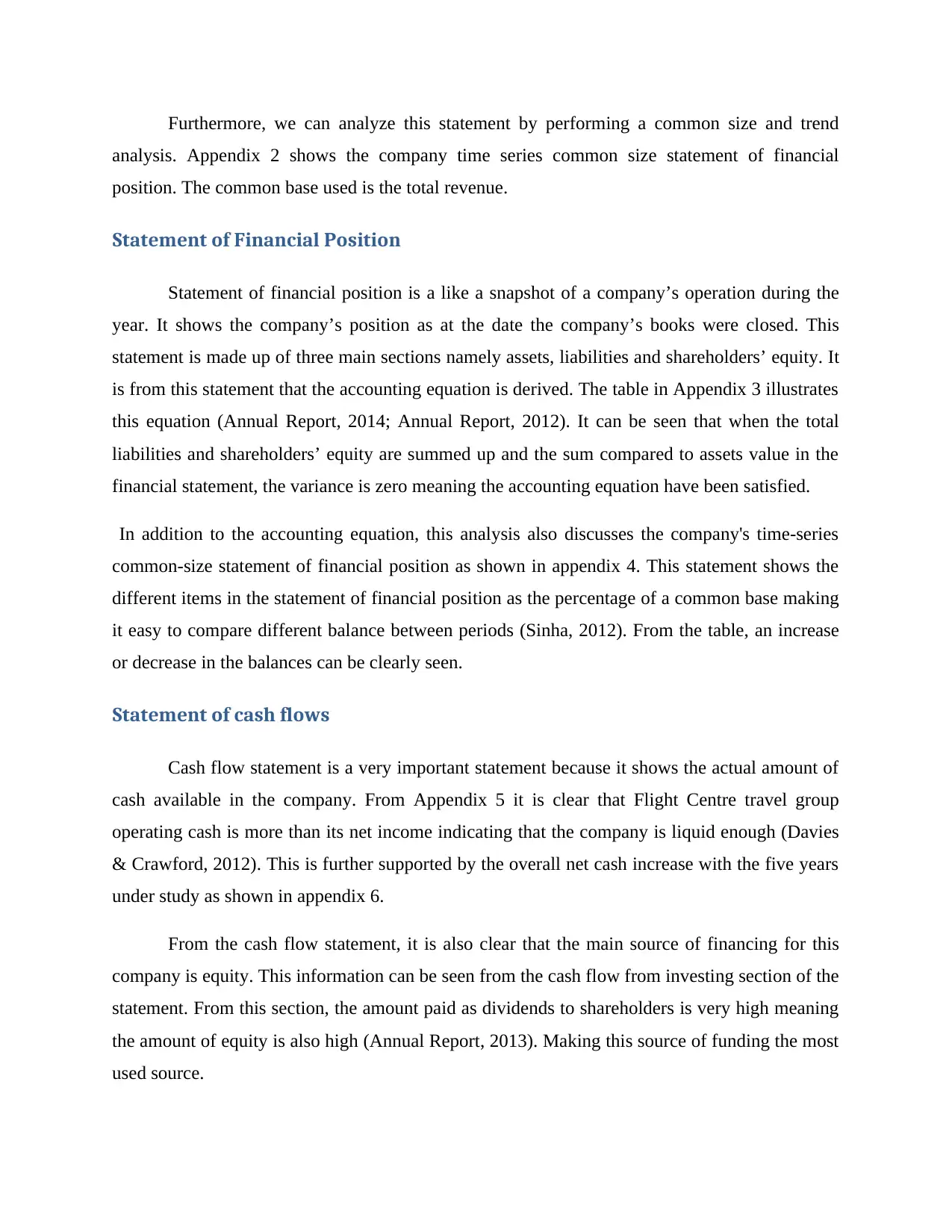
Furthermore, we can analyze this statement by performing a common size and trend
analysis. Appendix 2 shows the company time series common size statement of financial
position. The common base used is the total revenue.
Statement of Financial Position
Statement of financial position is a like a snapshot of a company’s operation during the
year. It shows the company’s position as at the date the company’s books were closed. This
statement is made up of three main sections namely assets, liabilities and shareholders’ equity. It
is from this statement that the accounting equation is derived. The table in Appendix 3 illustrates
this equation (Annual Report, 2014; Annual Report, 2012). It can be seen that when the total
liabilities and shareholders’ equity are summed up and the sum compared to assets value in the
financial statement, the variance is zero meaning the accounting equation have been satisfied.
In addition to the accounting equation, this analysis also discusses the company's time-series
common-size statement of financial position as shown in appendix 4. This statement shows the
different items in the statement of financial position as the percentage of a common base making
it easy to compare different balance between periods (Sinha, 2012). From the table, an increase
or decrease in the balances can be clearly seen.
Statement of cash flows
Cash flow statement is a very important statement because it shows the actual amount of
cash available in the company. From Appendix 5 it is clear that Flight Centre travel group
operating cash is more than its net income indicating that the company is liquid enough (Davies
& Crawford, 2012). This is further supported by the overall net cash increase with the five years
under study as shown in appendix 6.
From the cash flow statement, it is also clear that the main source of financing for this
company is equity. This information can be seen from the cash flow from investing section of the
statement. From this section, the amount paid as dividends to shareholders is very high meaning
the amount of equity is also high (Annual Report, 2013). Making this source of funding the most
used source.
analysis. Appendix 2 shows the company time series common size statement of financial
position. The common base used is the total revenue.
Statement of Financial Position
Statement of financial position is a like a snapshot of a company’s operation during the
year. It shows the company’s position as at the date the company’s books were closed. This
statement is made up of three main sections namely assets, liabilities and shareholders’ equity. It
is from this statement that the accounting equation is derived. The table in Appendix 3 illustrates
this equation (Annual Report, 2014; Annual Report, 2012). It can be seen that when the total
liabilities and shareholders’ equity are summed up and the sum compared to assets value in the
financial statement, the variance is zero meaning the accounting equation have been satisfied.
In addition to the accounting equation, this analysis also discusses the company's time-series
common-size statement of financial position as shown in appendix 4. This statement shows the
different items in the statement of financial position as the percentage of a common base making
it easy to compare different balance between periods (Sinha, 2012). From the table, an increase
or decrease in the balances can be clearly seen.
Statement of cash flows
Cash flow statement is a very important statement because it shows the actual amount of
cash available in the company. From Appendix 5 it is clear that Flight Centre travel group
operating cash is more than its net income indicating that the company is liquid enough (Davies
& Crawford, 2012). This is further supported by the overall net cash increase with the five years
under study as shown in appendix 6.
From the cash flow statement, it is also clear that the main source of financing for this
company is equity. This information can be seen from the cash flow from investing section of the
statement. From this section, the amount paid as dividends to shareholders is very high meaning
the amount of equity is also high (Annual Report, 2013). Making this source of funding the most
used source.
⊘ This is a preview!⊘
Do you want full access?
Subscribe today to unlock all pages.

Trusted by 1+ million students worldwide
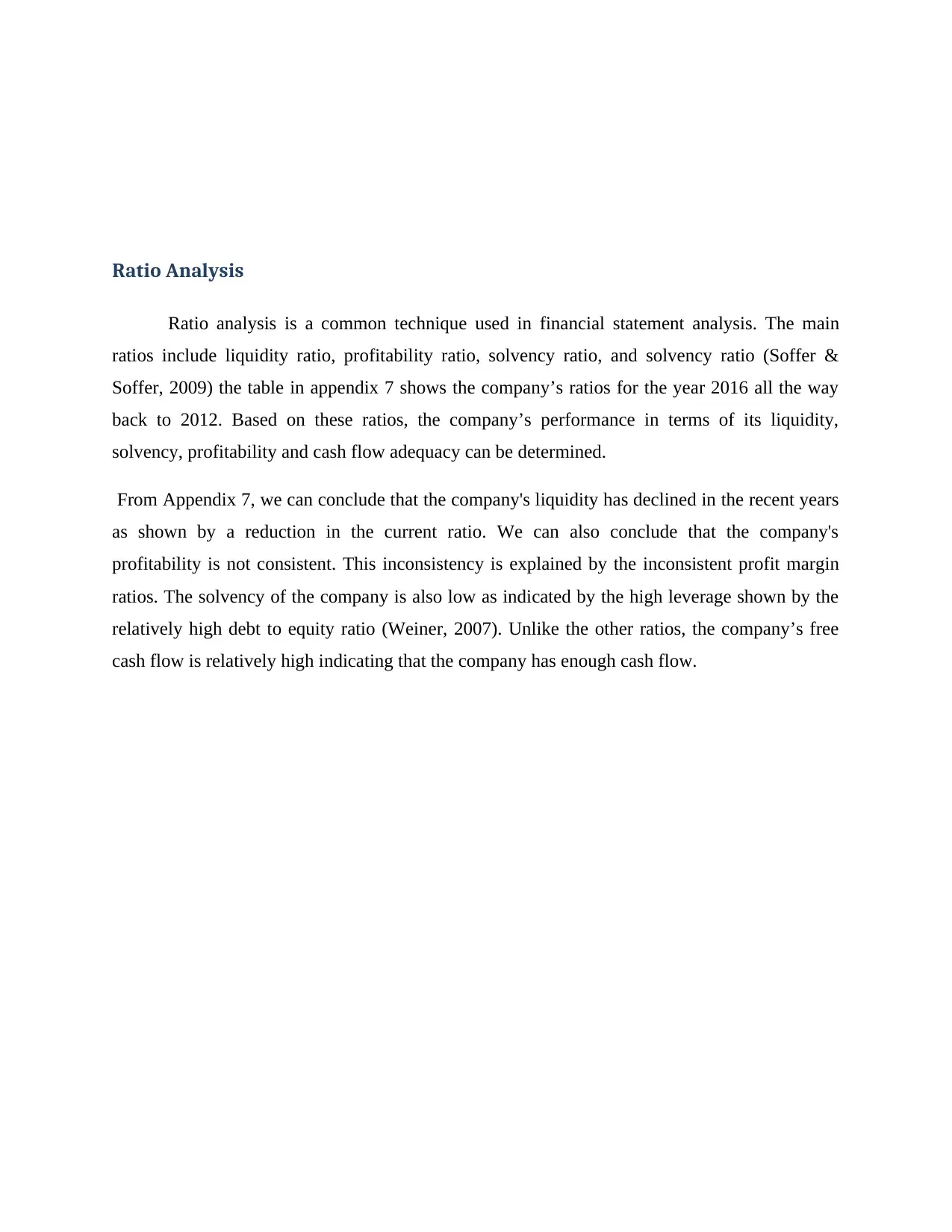
Ratio Analysis
Ratio analysis is a common technique used in financial statement analysis. The main
ratios include liquidity ratio, profitability ratio, solvency ratio, and solvency ratio (Soffer &
Soffer, 2009) the table in appendix 7 shows the company’s ratios for the year 2016 all the way
back to 2012. Based on these ratios, the company’s performance in terms of its liquidity,
solvency, profitability and cash flow adequacy can be determined.
From Appendix 7, we can conclude that the company's liquidity has declined in the recent years
as shown by a reduction in the current ratio. We can also conclude that the company's
profitability is not consistent. This inconsistency is explained by the inconsistent profit margin
ratios. The solvency of the company is also low as indicated by the high leverage shown by the
relatively high debt to equity ratio (Weiner, 2007). Unlike the other ratios, the company’s free
cash flow is relatively high indicating that the company has enough cash flow.
Ratio analysis is a common technique used in financial statement analysis. The main
ratios include liquidity ratio, profitability ratio, solvency ratio, and solvency ratio (Soffer &
Soffer, 2009) the table in appendix 7 shows the company’s ratios for the year 2016 all the way
back to 2012. Based on these ratios, the company’s performance in terms of its liquidity,
solvency, profitability and cash flow adequacy can be determined.
From Appendix 7, we can conclude that the company's liquidity has declined in the recent years
as shown by a reduction in the current ratio. We can also conclude that the company's
profitability is not consistent. This inconsistency is explained by the inconsistent profit margin
ratios. The solvency of the company is also low as indicated by the high leverage shown by the
relatively high debt to equity ratio (Weiner, 2007). Unlike the other ratios, the company’s free
cash flow is relatively high indicating that the company has enough cash flow.
Paraphrase This Document
Need a fresh take? Get an instant paraphrase of this document with our AI Paraphraser
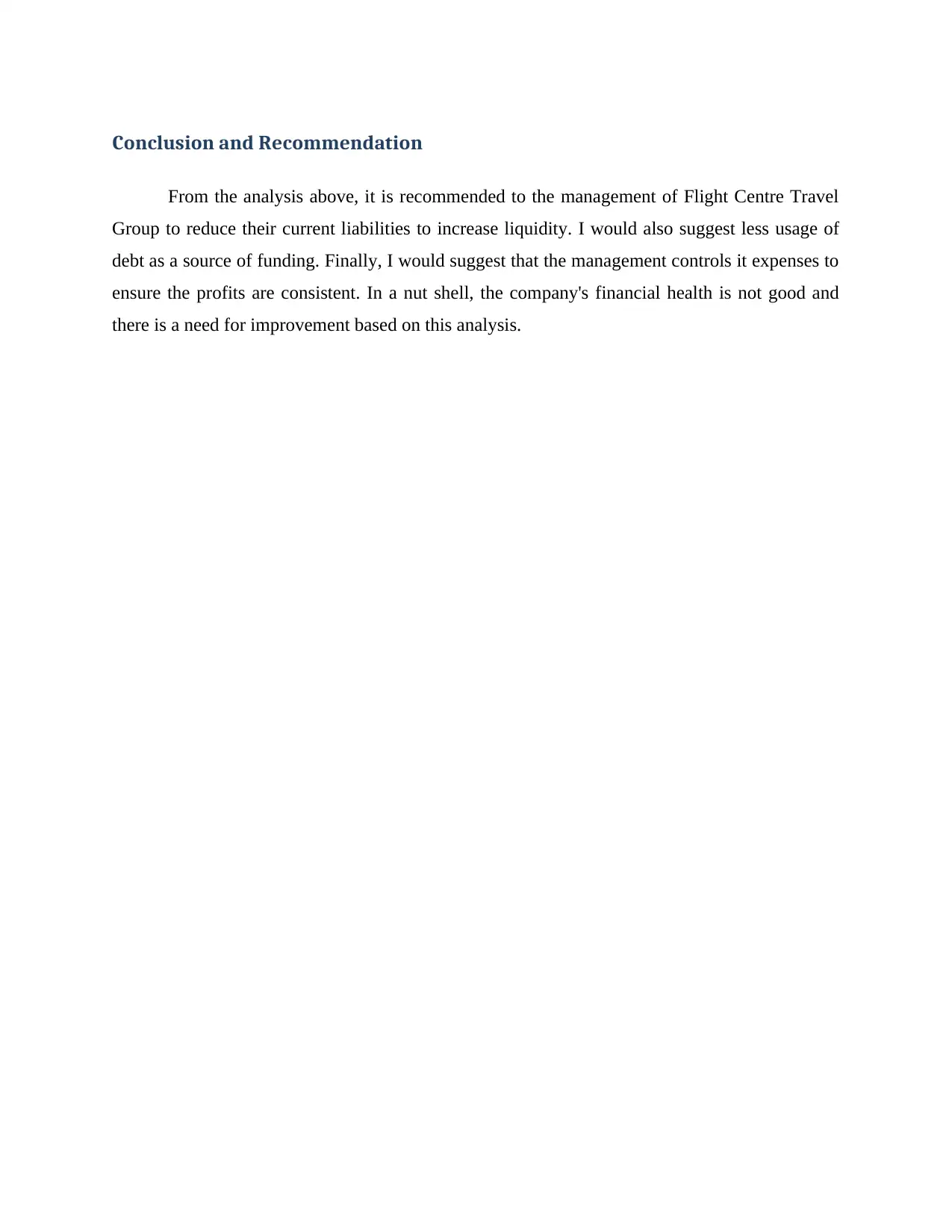
Conclusion and Recommendation
From the analysis above, it is recommended to the management of Flight Centre Travel
Group to reduce their current liabilities to increase liquidity. I would also suggest less usage of
debt as a source of funding. Finally, I would suggest that the management controls it expenses to
ensure the profits are consistent. In a nut shell, the company's financial health is not good and
there is a need for improvement based on this analysis.
From the analysis above, it is recommended to the management of Flight Centre Travel
Group to reduce their current liabilities to increase liquidity. I would also suggest less usage of
debt as a source of funding. Finally, I would suggest that the management controls it expenses to
ensure the profits are consistent. In a nut shell, the company's financial health is not good and
there is a need for improvement based on this analysis.
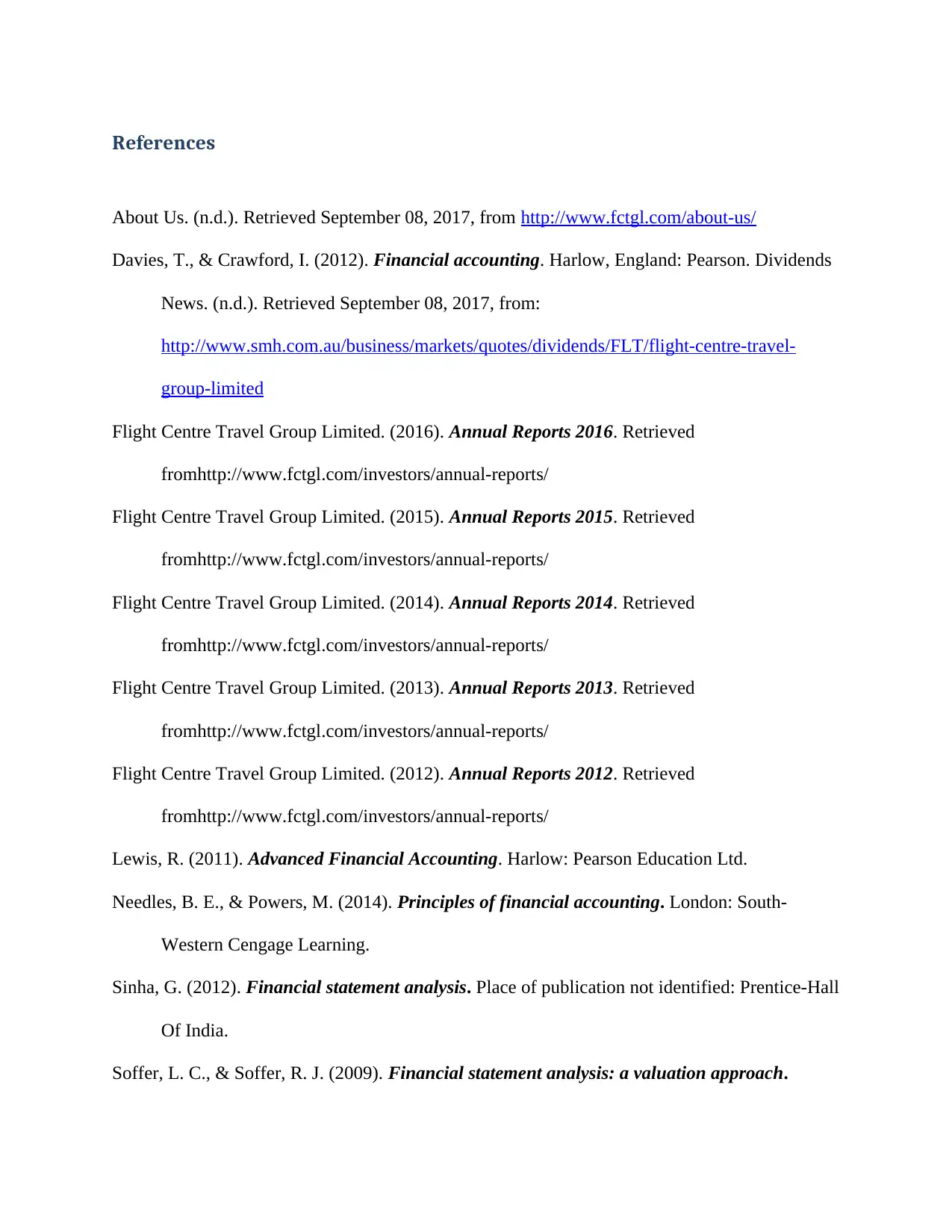
References
About Us. (n.d.). Retrieved September 08, 2017, from http://www.fctgl.com/about-us/
Davies, T., & Crawford, I. (2012). Financial accounting. Harlow, England: Pearson. Dividends
News. (n.d.). Retrieved September 08, 2017, from:
http://www.smh.com.au/business/markets/quotes/dividends/FLT/flight-centre-travel-
group-limited
Flight Centre Travel Group Limited. (2016). Annual Reports 2016. Retrieved
fromhttp://www.fctgl.com/investors/annual-reports/
Flight Centre Travel Group Limited. (2015). Annual Reports 2015. Retrieved
fromhttp://www.fctgl.com/investors/annual-reports/
Flight Centre Travel Group Limited. (2014). Annual Reports 2014. Retrieved
fromhttp://www.fctgl.com/investors/annual-reports/
Flight Centre Travel Group Limited. (2013). Annual Reports 2013. Retrieved
fromhttp://www.fctgl.com/investors/annual-reports/
Flight Centre Travel Group Limited. (2012). Annual Reports 2012. Retrieved
fromhttp://www.fctgl.com/investors/annual-reports/
Lewis, R. (2011). Advanced Financial Accounting. Harlow: Pearson Education Ltd.
Needles, B. E., & Powers, M. (2014). Principles of financial accounting. London: South-
Western Cengage Learning.
Sinha, G. (2012). Financial statement analysis. Place of publication not identified: Prentice-Hall
Of India.
Soffer, L. C., & Soffer, R. J. (2009). Financial statement analysis: a valuation approach.
About Us. (n.d.). Retrieved September 08, 2017, from http://www.fctgl.com/about-us/
Davies, T., & Crawford, I. (2012). Financial accounting. Harlow, England: Pearson. Dividends
News. (n.d.). Retrieved September 08, 2017, from:
http://www.smh.com.au/business/markets/quotes/dividends/FLT/flight-centre-travel-
group-limited
Flight Centre Travel Group Limited. (2016). Annual Reports 2016. Retrieved
fromhttp://www.fctgl.com/investors/annual-reports/
Flight Centre Travel Group Limited. (2015). Annual Reports 2015. Retrieved
fromhttp://www.fctgl.com/investors/annual-reports/
Flight Centre Travel Group Limited. (2014). Annual Reports 2014. Retrieved
fromhttp://www.fctgl.com/investors/annual-reports/
Flight Centre Travel Group Limited. (2013). Annual Reports 2013. Retrieved
fromhttp://www.fctgl.com/investors/annual-reports/
Flight Centre Travel Group Limited. (2012). Annual Reports 2012. Retrieved
fromhttp://www.fctgl.com/investors/annual-reports/
Lewis, R. (2011). Advanced Financial Accounting. Harlow: Pearson Education Ltd.
Needles, B. E., & Powers, M. (2014). Principles of financial accounting. London: South-
Western Cengage Learning.
Sinha, G. (2012). Financial statement analysis. Place of publication not identified: Prentice-Hall
Of India.
Soffer, L. C., & Soffer, R. J. (2009). Financial statement analysis: a valuation approach.
⊘ This is a preview!⊘
Do you want full access?
Subscribe today to unlock all pages.

Trusted by 1+ million students worldwide
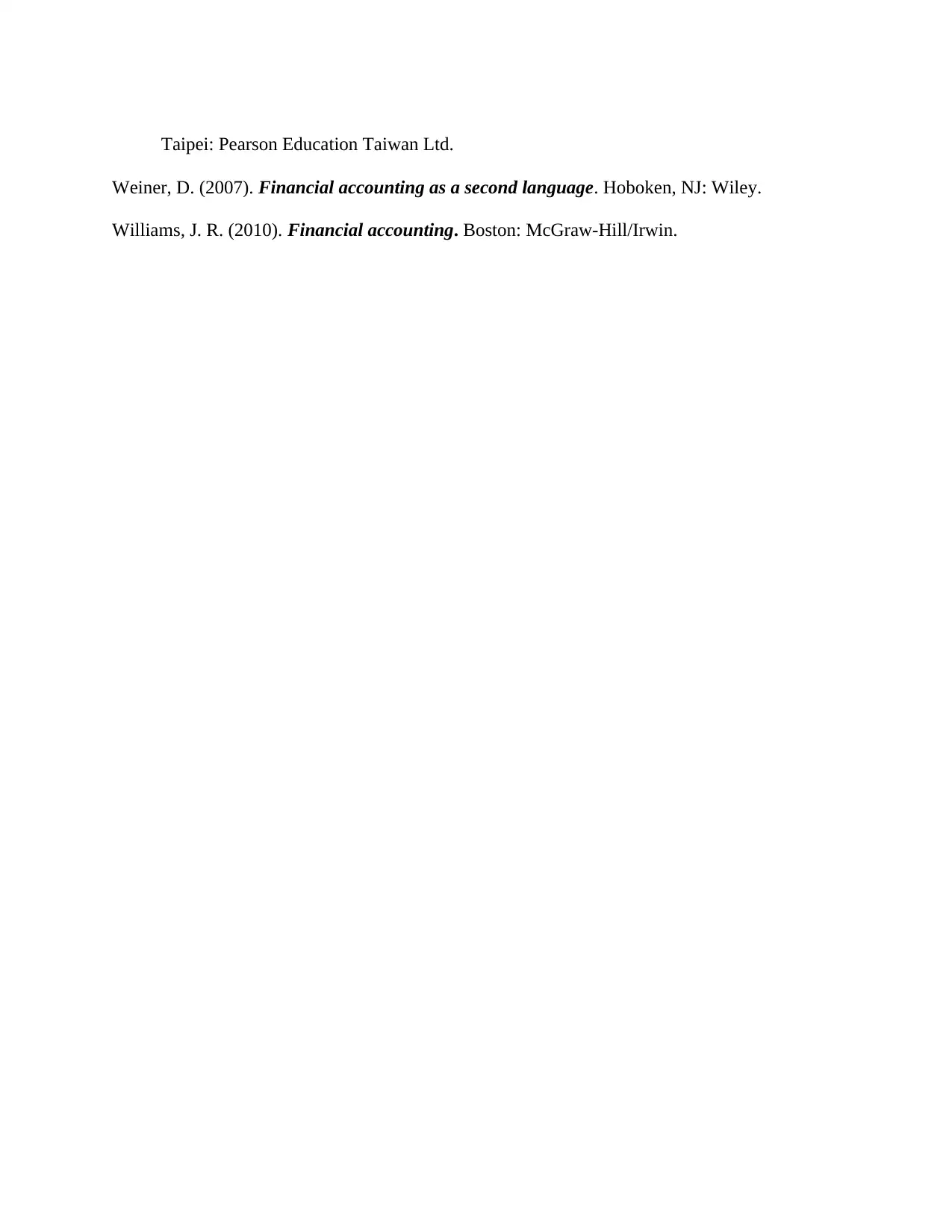
Taipei: Pearson Education Taiwan Ltd.
Weiner, D. (2007). Financial accounting as a second language. Hoboken, NJ: Wiley.
Williams, J. R. (2010). Financial accounting. Boston: McGraw-Hill/Irwin.
Weiner, D. (2007). Financial accounting as a second language. Hoboken, NJ: Wiley.
Williams, J. R. (2010). Financial accounting. Boston: McGraw-Hill/Irwin.
1 out of 10
Related Documents
Your All-in-One AI-Powered Toolkit for Academic Success.
+13062052269
info@desklib.com
Available 24*7 on WhatsApp / Email
![[object Object]](/_next/static/media/star-bottom.7253800d.svg)
Unlock your academic potential
Copyright © 2020–2025 A2Z Services. All Rights Reserved. Developed and managed by ZUCOL.




